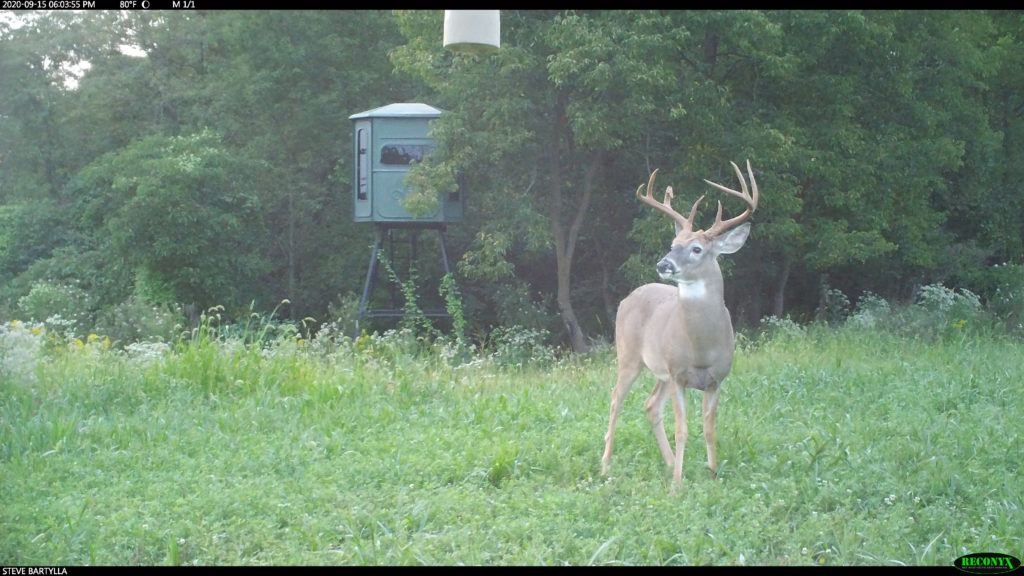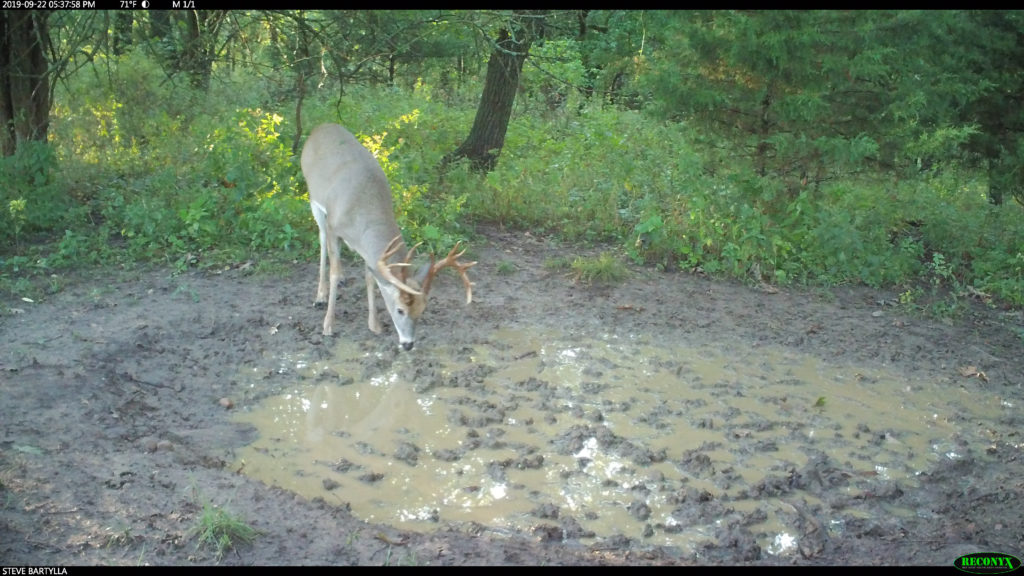Most all wild animals are subjected to weather, and deer aren’t exceptions. When one understands how weather impacts deer movements and even areas they gravitate to, under specific weather conditions, we can obviously better position ourselves for success. Here’s how to achieve just that.
This is Chapter 15 of Steve Bartylla’s free online book, Understanding Mature Bucks.
So, last chapter I wrote about how we’re only talking tendencies here and that, frankly, I don’t like writing about how weather impacts deer movements, as I find data like that discourages hunting more than encourages it. As I said then, and to make myself sound like an arrogant jerk once again, I’ve shot a bunch of mature bucks that didn’t know the conditions said they shouldn’t be moving.
So, rather than droning on about rising barometric pressure, between 29.8 and 30.30 is best for movement and feeding. Regardless of rising, falling or relatively steady pressure, anything within this range can be good. Steady or falling pressure below that range is generally bad, with rising being best, even if below the sweet spot and a bunch of stuff on the moon and wind and temperature ranges and such. Let’s talk about some more big picture stuff, instead.
The one exception is I need to talk temperature drops really quickly, as they are just too powerful not to. Almost regardless of the actual temperatures, most any time you have a stretch of 5+ days with temperatures being around the same and the forecast calling for a 10+ degree drop in temperatures, get your butts out in the woods that day, if you can. That temperature drop does wonders for getting that buck to hit a food source before dark that he’d been arriving at two hours after, as well as inspiring a lot more rutting behavior, regardless of the true phase of season.

With that out of the way, let’s talk about the rut. As alluded to in previous chapters, young bucks make us look silly when we try to use their actions to determine the rut phase. They are clueless to, as it applies to the art and science of the rut, what they’re supposed to be doing, how and even why, to an extent.
Mature bucks KNOW what they’re doing, but, remember, they don’t dictate when does come into estrus. So, even mature buck behaviors can be very deceiving, and those deceptions tend to revolve around weather conditions.
Think of it this way. It’s Nov. 10, somewhere in the farm belt or points north. You can pick for the weather conditions between three options: 85 degrees, calm and sunny is option one. Two is -20, with 45 mph wind gusts, 28 mph sustained. The third option is 25 degrees, light wind, partly cloudy.
Which day are you going to pick and why? That little exercise just made the point that Mr. Big’s activity levels will be impacted by the weather. No, the does’ estrous states aren’t, but how many of you believe you could run marathons in 85 degree temperatures, sun beating down on you, while wearing the level of clothing needed to survive sleeping outside in negative temps? How about while wearing all of that, but temperatures in the negative numbers, with a 45 mph wind? It won’t matter how BAD you want to run that marathon, you either aren’t going to do it or run way less of it and far slower than you otherwise would, under either of those two extremes. Why would Mr. Big be so much different?
Read: Charles Alsheimer’s 7 Lasting Lessons
The points are twofold. One is that weather definitely impacts Mr. Big’s behaviors. The other is that temperature changes can make it seem like the breeding phase is active when it’s not and not when it really is. Keying in on does is really the way to tell when the breeding phase is here. Does will be without fawns and either laying low, as they don’t want to be harassed, or advertising their estrous state by actively searching for bucks and wafting their odors as they do (tail straight up, straight out or acting like a windshield wiper, fanning the odors (does often fan for bugs, too … so, don’t let that trip you up)).
As I already stated, I generally try not to pay too much attention to the weather, as it applies to if the deer will move today or not. Frankly, I often don’t care that much if the majority of deer are shut down, as I’m typically only hunting a couple deer any time I head for stands. One of them comes by at 25 yards and I really could care less that most other deer are in bed, and that’s happened way more than enough to me to show that’s a legit possibility.
However, I do tend to stay away from my best stands for that phase of season, when conditions are really bad for movement. Frankly, I don’t go into high impact stands unless the conditions are good-great.
I also factor weather into more decisions. That 85-degree rut option we just discussed, you can bet your last dollar that I’ll be out every morning of that hunt, sitting either on a doe bedding area or funnel between doe bedding and Mr. Big’s bedding or just between separate family/doe groups. Remember covering how that late-season buck wants to feed in the early evening and be bedded most of the night and in the morning to save body heat during that coldest part of the 24-hour cycle?
Reverse that for unseasonably hot stretches during the rut. With his winter coat making those high temperatures that much unbearably worse, Mr. Big is better off rutting in the middle of the night, on through early morning, during that coolest portion of the 24-hour cycle. You can bet I’ll be in stand on those mornings, as that’s by far the best odds I have of meeting Mr. Big, under those specific conditions.
Generally speaking, that’s how I factor weather into all of this. Unless unsafe, I don’t allow weather to stop me from hunting. However, I do try to factor in how Mr. Big will react to the weather.
For example, if it’s super windy, I’m going to be hunting somewhere sheltered from the wind. If it’s extremely hot, water and shaded plots are generally better choices than that wide-open field. When precipitation is hard enough to impact movements, yet not hard enough to ruin blood trailing, I’ll often target areas offering some shelter from the precipitation.

Just please remember that this type of stuff is all relative. What’s super windy in Pennsylvania will be a light breeze in Kansas. What’s hot in Minnesota will be considered chilly in southern Illinois and downright cold in Texas.
I’m sure this chapter actually disappointed some, as there is an understandable hunger for finding that magical combo of weather factors, all but locking Mr. Big into being 20 yards in front of you. Here’s what I’ve found from over 34 years of chasing various furbearers. Just like with fish, there are certainly conditions that make deer more and less active. Here’s the rub, though. I’ve had way too many flat out incredible, covered up with deer type sits in what are supposed to be horrible conditions to allow those conditions to stop me from going out, assuming it’s safe and I want to.
Ninety-some degrees, full moon, rock bottom barometric pressure in central Illinois on Nov. 16. I’m literally walking to stand in my boxers, a pair of socks, rubber boots and a tee shirt, carrying everything else and still sweating like crazy. I hear the deer snorting around me as I’m bathing in Scent Killer at the base of the tree, before getting dressed (and that had to be a pretty picture … all of it).
I passed somewhere over a dozen different bucks that sit, came one step from shooting a 200+” stud and arrowed a mid-150s. Absolutely EVERYTHING weather related was stacked against that hunt, yet it was a Top 10 sit in my life. I can give example after example after example of GREAT sits on seemingly horrible deer movement days.
So, here’s my real point in all of this. In my honest opinion, it makes all the sense in the world to understand how deer are supposed to react to weather. By all means, please consume the heck out of that stuff, and there are all sorts of studies out there on this. Find and consume them, but do NOT allow their findings to stop you from hunting, assuming you want to that day and it’s safe out there. Instead, merely ask how those conditions will most likely impact Mr. Big and factor that into your stand choice.
Read Chapter 1: Whitetail Tendencies
Read Chapter 2: Whitetail Home Ranges
Read Chapter 3: How Deer Use Core Areas
Read Chapter 4: When Core Areas Shift
Read Chapter 5: Seasonal Shifts
Read Chapter 6: Family Group Dominance
Read Chapter 7: Male Dominance
Read Chapter 8: Deer Population Dynamics
Read Chapter 9: Deciphering Deer Breeding Phases
Read Chapter 10: Big Deer Breeding Behavior
Read Chapter 11: Whitetail Rut Stress
Read Chapter 12: How Deer Deal With Winter Stress
Read Chapter 13: Master Whitetail Phases


